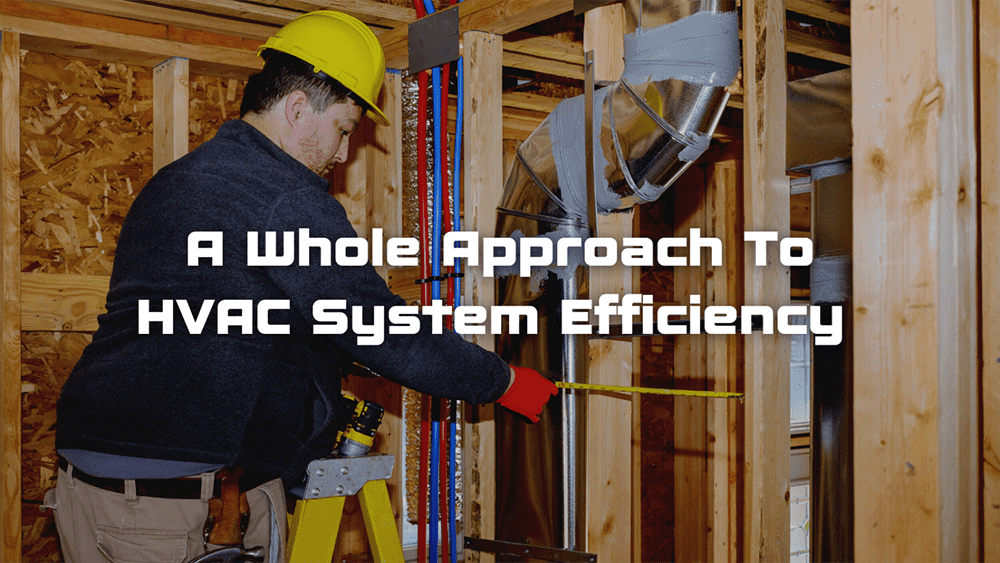A Whole Approach To HVAC System Efficiency

Many HVAC Professionals ignore the benefits of approaching complex systems as a whole. They buy into equipment models that create changes in one area. But these affect the dynamics and, therefore, the effectiveness of other areas. We recommend a whole approach to HVAC system efficiency.
Levels of System Efficiency
“System Efficiency” has several levels, listed below. The challenge is managing them as a whole.
Equipment Efficiency – Efficiently converting fuel/energy into usable BTUs.
Duct Efficiency – Efficiently moving air from the RA grills through the equipment and to the SA registers. Ducts that are too small require more energy; ducts that are too big reduce critical register velocity.
BTU (British Thermal Units) Delivery Efficiency – Provides an effective velocity/throw from the register into the space. Insufficient throw impedes proper mixing causing excessive stratification.
Design Efficiency – The capability of the system design to meet the load diversity of the structure, from the equipment size down to the style and location of the registers. Designing for variety is significantly different than designing for average loads.
Control Management Efficiency – Provides the most efficient equipment operation to meet the present comfort demands. For example, serving 100% of the duct system with 60% of the capacity does not provide effective air delivery, and 100% of the capacity to serve 40% of the duct system is also problematic.
Operating Efficiency – The comprehensive, convenient, and unproblematic interface between the operator (Homeowner) and the system. Consumers need an easy way to manage HVAC systems, more than set-points and set-backs.
A Whole Approach to Efficiency
This type of system management requires a central control point. This control point receives and employs information from the whole system. Then it provides the desired comfort level at the most effective and efficient operation. When we look at HVAC efficiency as defined in the efficiency types mentioned above, we can measure how much energy we use to maintain whole-house comfort. That’s the importance of “whole” HVAC system management.
Zoning Systems for Effective Energy Management
A properly designed and installed zoning system is vital for effective energy management in a residential structure. A “Smart” home needs more than just a way to control the output capacity of a system to reduce energy consumption at any given time. It must also have the ability to direct that reduced capacity to the area of the home that is occupied. Operating equipment at a lower output capacity to decrease energy consumption is a significant savings opportunity, but delivering that reduced capacity through 100% of the duct system creates many effectiveness issues. Most of these issues stem from the reduction of the face velocity at the supply outlets.
Modulating zone dampers to meet lower load requirements is counterproductive in the challenge of maintaining effective register velocity and proper mixing in the room. The result is still less air being delivered at the register. On a non-variable piece of equipment operating at one set cfm value, zone damper modulation will possibly increase cfm/velocity in zones that are 100% open but will reduce cfm/velocity in zones that are being modulated and receiving less than they were designed for.
This effect is very well explained in Manual D, page 1-1:
“Most designers appreciate the significance of the supply and return paths, but some underestimate the importance of the supply air outlets. For example, if the supply outlets are too large, the supply air will not be projected into the room and will not mix with the air. During the cooling season, the air will drop to the floor. At the upper level of the house, the air that falls out of the ceiling outlets will accumulate on the floor and fall down the stairway or fall off the balcony. As the cascade of cool air reaches the floor, it will merge with the puddle of cold air created by the (oversized) first floor outlets. When this happens, the room air is still relatively warm and will drift up to the upper level and stratify near the ceiling. The net effect will be that the upper level will get too warm, and the lower level will be too cold. Furthermore, the same problem will be experienced during the heating season. In this case, the inadequate mixing that is associated with the oversized supply outlets will still cause the warm supply air to stratify at the upper level.”
How can we buy into the thought that a multi-stage or variable output piece of equipment can overcome the dilemma mentioned above? Why would we continue to sell this equipment without an adequate zoning system to manage the airflow?
Designing a System That Works
The typical variable speed two-stage units will deliver approximately 50 to 70 cfm during low-stage operation. The recommended “Face Velocity” of a residential supply air register per Hart & Cooley is 500-fpm to 800fpm. A typical 4″ x 10″ register would equate to 100-cfm to 170-cfm. This happens to be the range of air delivery that Arzel recommends for open/closed dampers regarding min/max airflow at the registers.
This design method will require much less bypass cfm and increase the delivered cooling capacity by approximately 50% when serving less than 100% of the zones. When you utilize a zone panel that stages on zone weight, the bypass requirement becomes even lower and eliminates the need in many applications.
This is simply just manipulating the system dynamics within the ranges of proper design criteria to allow the system to operate at its peak effectiveness while minimizing efficiency reduction at the equipment. Typically what we lose in equipment efficiency we gain in delivered BTU effectiveness.
Simple Control Method to Reduce Energy Consumption
The reality is that zoning two-stage equipment with the proper control strategy is a real and obtainable solution to reducing energy consumption, especially during peak load times. This simple control method allows the system to serve the critical, occupied areas only while operating in low-stage, reducing power consumption by 50% or more. One would think that this would be of interest to an energy commission.
The ideal forced-air system has multiple thermostat locations that would meet the load diversity of the space, deliver BTU capacity to the area(s) that require conditioning and stage the equipment to maintain an adequate air delivery into the space.
Questions on how to install Arzel Zoning for the best system efficiency? Contact us for free help with application design, or schedule your One-on-One training to learn how simple Arzel Zoning systems are to install efficiently with multi-stage and variable speed equipment.






